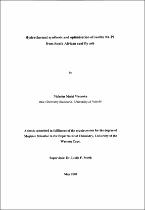| dc.description.abstract | Millions of tonnes of fly ash are generated worldwide every year to satisfy the large demand for
energy. Management of this fly ash has been a concern and various approaches for its beneficial
use have been investigated. Over the last two decades, there has been intensive research
internationally that has focused on the use of different sources of fly ash for zeolite synthesis.
However, most of the studies have concentrated on class C fly ash and very few have reported
the use of South African class F fly ash as feedstock for zeolite synthesis. Class F fly ash from South Africa has been confirmed to be a good substrate for zeolite synthesis due to its compositional dominance of aluminosilicate and silicate phases. However, because
differences in quartz-mullite/glass proportions of fly ash from different sources produces impure
phases or different zeolite mineral phases under the same activation conditions, the present study focused on optimization of synthesis conditions to obtain pure phase zeolite Na-P I from class F South African coal fly ash. Synthesis variables evaluated in this study were; hydrothermal treatment time (12 - 48 hours), temperature (100 - 160 oC) and addition of varying molar quantities of water during the hydrothermal treatment step (HzO:SiOz molar ratio ranged between 0 - 0.49).Once the most suitable conditions for the synthesis of pure phase zeolite Na-Pl from fly ash were identified, a statistical approach was adopted to refine the experiments, that was designed to evaluate the interactive effects of some of the most important synthesis variables. In this case,
the four synthesis variables; NaOH concentration (NaOH: SiOz molar ratio ranged between 0.35 - 0.71), ageing temperature (35 'C - 55 'C), hydrothermal treatment time (36 - 60 hours) and temperature (130 "C - 150 oC) were studied. The response was determined by evaluating the improvement in the cation exchange capacity of the product zeolite. The starting materials (fly ashes from Arnot, Hendrina and Duvha power stations) and the synthesized zeolite product were characteized chemically, mineralogically and morphologically by X-Ray fluorescence spectrometry, X-ray powder diffraction, scanning electron microscopy, and transmission electron microscopy. Other ch.aracterization technique used in the study wereFourier transform infrared spectroscopy to provide structural information and also monitor
evolution of crystallinity during slmthesis, as well as cation exchange capacity to determine the amount of exchangeable positively charged ions. Nitrogen adsorption was used to determine the surface area and porosity, and inductively coupled mass spectrometry for multi-elemental analysis of the post-synthesis supernatants | en_US |

